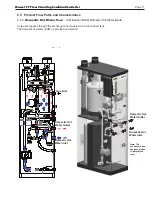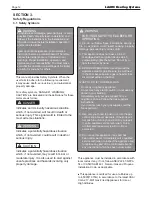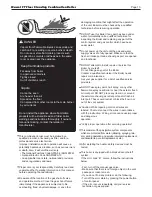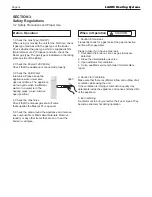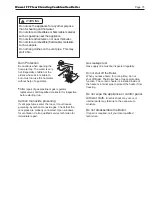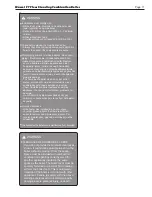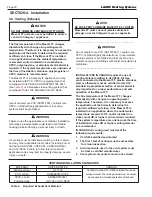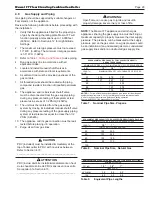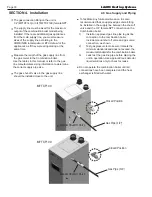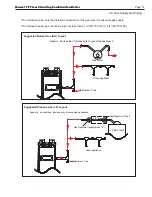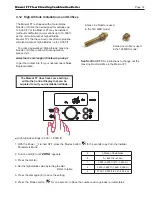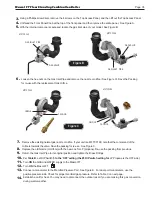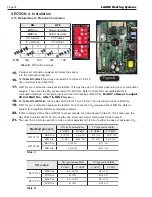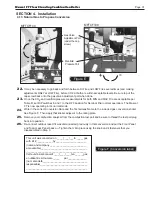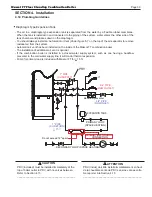
Mascot FT Floor Standing Combination Boiler
Page 25
NOTICE
At the time of removal of an existing boiler, the following steps
shall be followed with each appliance remaining connected to
the common venting system placed in operation, while the other
appliances remaining connected to the common venting system
are not in operation.
1. Seal any Not Used openings in the common venting system.
2. Visually inspect the venting system for proper size and
horizontal pitch and determine there is no blockage or
restriction, leakage, corrosion and other deficiencies which
could cause an unsafe condition.
3. Insofar as is practical, close all building doors and windows
and all doors between the space in which the appliances
remaining connected to the common venting system are
located and other spaces of the building. Turn on clothes
dryers and any appliance not connected to the common
venting system. Turn on any exhaust fans, such as range
hoods and bathroom exhausts, so they will operate at
maximum speed.
4. Place in operation the appliance being inspected. Follow the
lighting instructions. Adjust thermostat so the appliance will
operate continuously.
5. Operate the main burner for 5 minutes then, determine if the
cut-draw overflows to the discharge opening. Use the flame
of a match or a candle or the smoke of a cigarette, a cigar or
a pipe
6. Once it has been determined, according to the method
indicated above, that each device connected to the drainage
system is placed in the open air in an adequate manner.
Install the doors and windows, fans, the registers of chimneys
and gas appliances to their original position
7. Any malfunction of the venting system should be corrected so
that the installation conforms to the National Fuel Gas Code,
ANSI Z223.1/NFPA 54 and (or) the installation codes CAN/
CSA-B149.1. If the size of a section of the evacuation system
must be changed, the system should be modified to comply
with the minimum values of the relevant tables of appendix F
of the National Fuel Gas Code, ANSI Z223.1/NFPA 54 and
(or) the installation codes CAN/CSA-B149.1
Common Vent Test
NOTE: This section does not describe a method for
common venting Mascot FT units. It describes what
must be done when an existing unit is
removed
from
a common vent system.
AVIS
Au moment du retrait d'une chaudière existante, les mesures
suivantes doivent être prises pour chaque appareil toujours raccordé
au système d'évacuation commun et qui fonctionne alors que
d'autres appareils toujours raccordés au système d'évacuation ne
fonctionnent pas:
1. Sceller toutes les ouvertures non utilisées du système
d'évacuation.
2. Inspecter de façon visuelle le système d'évacuation pour
déterminer la grosseur et l'inclinaison horizontale qui conviennent
et s'assurer que le système est exempt d'obstruction,
d'étranglement, de fuite, de corrosion et autres défaillances qui
pourraient présenter des risques.
3. Dans la mesure du possible, fermer toutes les portes et les
fenêtres du bâtiment et toutes les portes entre l'espace où les
appareils toujours raccordés au système d'évacuation sont
installés et les autres espaces du bâtiment. Mettre en marche
les sécheuses, tous les appareils non raccordés au système
d'évacuation commun et tous les ventilateurs d'extraction comme
les hottes de cuisinière et les ventilateurs des salles de bain.
S'assurer que ces ventilateurs fonctionnent à la vitesse maximale.
Ne pas faire fonctionner les ventilateurs d'été. Fermer les registres
des cheminées.
4. Mettre l'appareil inspecté en marche. Suivre les instructions
d'allumage. Régler le thermostat de façon que l'appareil fonctionne
de façon continue.
5. Faire fonctionner le brûleur principal pendant 5 min ensuite,
déterminer si le coupe-tirage déborde à l'ouverture de décharge.
Utiliser la flamme d'une allumette ou d'une chandelle ou la fumée
d'une cigarette, d'un cigare ou d'une pipe.
6. Une fois qu'il a été déterminé, selon la méthode indiquée ci-
dessus, que chaque appareil raccordé au système d'évacuation
est mis à l'air libre de façon adéquate. Remettre les portes et
les fenêtres, les ventilateurs, les registres de cheminées et les
appareils au gaz à leur position originale.
7. Tout mauvais fonctionnement du système d'évacuation commun
devrait être corrigé de façon que l'installation soit conforme au
National Fuel Gas Code, ANSI Z223.1/NFPA 54 et (ou) aux codes
d'installation CAN/CSA-B149.1. Si la grosseur d'une section
du système d'évacuation doit être modifiée, le système devrait
être modifié pour respecter les valeurs minimales des tableaux
pertinents de l'appendice F du National Fuel Gas Code, ANSI
Z223.1/NFPA 54 et (ou) les codes d'installation CAN/CSA-B149.1
NOTICE
DO NOT COMMON VENT MASCOT FT UNITS.
Mascot FT units are never permitted to share a
vent with Category I appliances.
AVIS
NE PAS ÉVENT COMMUNE MASCOTTE FT UNITÉS.
Mascotte FT unités ne sont jamais autorisés à
partager un évent Catégorie I avec les appareils.
Summary of Contents for MFTCF140
Page 48: ...LAARS Heating Systems Page 46 4 19 Control Board Electrical Diagram SECTION 4 Installation...
Page 65: ...Mascot FT Floor Standing Combination Boiler Page 63 6 2 Fault Tree Analysis 1 Flame detection...
Page 75: ...Mascot FT Floor Standing Combination Boiler Page 73...
Page 78: ...LAARS Heating Systems Page 76 Heat Exchanger MFTCF140...

